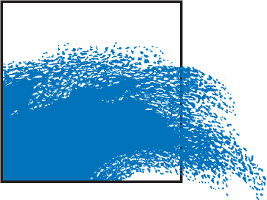Combatting air pollution above the sea (MARPOL Annex VI)
Resume
Since 2015 a ‘sniffer’ sensor is deployed on board of the Belgian Coast Guard aircraft that allows to determine the sulphur content in the fuel from measurements realized above sea in the emissions from ships. These new "sulphur monitoring flights" from MUMM were started as part of the European pilot project "CompMon" (Compliance Monitoring), with the aim of contributing to the enforcement of the strict sulphur emission standards laid down in Annex VI of the international MARPOL 73/78 Treaty and the European Sulphur Directive, in addition to the port state inspections - implemented in Belgium by the Shipping Directorate-General (FPS Mobility). The reduction of sulphur emission (or SOx) from shipping is, after all, a top European priority for various important public health and environmental reasons (particulate matter, acid rain and acidification of oceans, etc.).
In the second part of 2019, the sniffer sensor will be expanded with a NOx sensor, so that the Belgian coastguard aircraft will, in addition to the sulphur measurements, also be able to monitor the latest NOx emission standards from the air.
This method not only allows more efficient monitoring of the influence of shipping on air quality above sea, but also allows identification of potential offenders and reporting to the competent port inspection services. Internationally, more and more people are looking in the Belgian direction in this regard. For example, all North Sea coastal states are considering rolling out monitoring of SOx and NOx emissions from ships at sea across the entire North Sea, within the framework of the Bonn Agreement. Even countries far outside Europe such as China or Canada showed already great interest in this European pioneering work.
-
Maritime policies on SOx and NOx: SECA, Global Sulphur Cap, NECA
-
Role of the surveillance aircraft: Aerial monitoring of sulphur emissions from ships at sea
Environmental and public health effects of ship's emissions
Shipping influences people and the environment in various ways. Awareness for the impact of air pollution caused by exhaust gases from ships has increased significantly during recent year. By burning fossil fuels, shipping is responsible for a significant share of the global emission of pollutants into the air. The most important air pollutants in these exhaust gases are sulphur oxides (SOx), nitrogen oxides (NOx) and soot particles such as Black Carbon (BC) - which are also greenhouse gases (GHG) from shipping (next to CO2 emission from ships).

SO2 is an irritating gas that acts in synergy with other substances, such as suspended particles. At high concentrations, it can have serious health consequences. SO2 modifies lung functioning of children and may causes cardiovascular and lung diseases for adults. Sulphur dioxide emissions are also at the basis of the formation of toxic fog, better known as smog.
NOx emissions play a role in the formation of particulate matter and eutrophication of the marine and terrestrial environment. NOx is also one of the ozone precursors in the lower air layers. Ground ozone formation can lead to significant respiratory problems and is also a greenhouse gas.
In addition, SO2 and NOx emissions from ships both contribute to the acidification of coastal regions along busy traffic zones. Once released into the air SO2 forms in reaction with water, sulphuric acid (H2SO4), NOx is transformed to nitric acid (HNO3), these reactions are the basis of the phenomenon of acid rain causing damage to infrastructure (e.g. buildings...) and ecosystems, and can threaten biodiversity due to possible damage to sensitive species (e.g. shellfish and crustaceans, who are more difficult to produce their lime shell in a more acidic environment). Ocean acidification by SO2 and NOx emission is global rather small, but the deposition of SO2 can have a significant impact for heavily used coastal waters that are more vulnerable, and may in the long term, for example, affect the economic potential (e.g. for shellfish culture).
Where the adverse effects of primarily SO2 and NOx ashore is long recognized and stringent regulation for e.g. powerplants and transportation have led to a significant decrease in harmful emission, the regulation of emission from shipping long remained substandard despite the adverse effects for the marine environment.
In addition to SOx and NOx emissions, international shipping is also a major source of emissions of Particulate Matter (PM), Black Carbon (BC), and CO2 . BC (particles with a diameter between 20-150 nm) forms a sub-category of fine dust (particles with a diameter smaller than 2.5 µm). PM is created by an incomplete combustion of fossil fuels and caused by the light absorption effects of carbon black particles, the second largest human contributor to global warming, after CO2 and accelerates global warming, especially in the North Pole area. Fine dust can penetrate deep into our respiratory system, into the alveoli. Since fine dust serves as a carrier for a variety of toxic substances (such as e.g. aromatic hydrocarbons and heavy metals) the effect on human health, such as cardiovascular and pulmonary disorders, should not be underestimated. The switch-over from heavy fuel oil to low-sulphur, alternative and cleaner fuels could significantly reduce the emissions of particulate matter and BC. Depending of the source, the estimates range from about 30 % to 80%.
Maritime policies on SOx and NOx: SECA, Global Sulphur Cap, NECA
In the absence of adequate regulation, ship emissions would continue to increase as a result of the growth of shipping, while emissions from road transport show a downward trend. In the specific case of SOx emissions, it was already concluded in 2005 that sulphur emissions from shipping in the EU without further policy action, would become greater than the combined emissions from all land-based sources in the EU in 2020. Therefore, a series of international policy measures were initiated to drastically limit air emissions from ships.
The international environmental standards for ships are developed and laid down by the International Maritime Organization (IMO) under the MARPOL 73/78 Convention. MARPOL Annex VI, first approved in 1997 and revised in 2008, envisages a gradual decrease of emissions of SOx and particulates (in regulation 14) and NOx (in regulation 13) on a global scale. MARPOL Annex VI introduced emission control areas or " Emission Control Areas (ECAs) as well where more stringent emission limits for air pollutants from ships apply. In the European Union, SOx emissions from ships is regulated by the Sulphur Directive (Directive (EU) 2016/802).
In 2000 stricter standards were agreed for the sulphur content in marine fuels in certain sea areas, the so-called sulphur emission control areas or SECA areas. Following the Baltic Sea, the North Sea and the English Channel became SECA regions as well in 2006. This implies that vessels in SECA areas, only may use fuel with a lower sulphur content or that they must use approved exhaust gas-cleaning systems, the so-called ‘Scrubbers’ to wash out the sulphur compounds from the exhaust gasses in order to achieve the same emission level as with low sulphur fuels. Using natural gas, mostly Liquified Natural Gas, as fuel, ships can meet the MARPOL Annex VI regulations as well. Since January 1, 2015 the emissions limits were even more tightened and ships in the Baltic Sea, North Sea and English Channel only can use fuel with a maximum sulphur content of 0.10%.
Worldwide (outside the SECAs) the limit for the sulphur content in ship fuels is until late 2019 still 3.5%. On January 1, 2020, however, the maximum sulphur content worldwide will be limited to 0.5%, the so-called 'Global Sulphur Cap' from MARPOL Annex VI. The efficient implementation of these MARPOL Annex VI rules is a European top priority (European Sulphur Directive).

Reduction of nitrogen emission from ships: NECA
In addition to the worldwide tightening of standards for sulphur emission from shipping, action is also being taken to reduce NOx emission. MARPOL Annex VI Prescription 13 defines the limits of the NOx emission for marine diesel engines.
The NOx emission limit values apply to every marine diesel engine with a capacity of more than 130 kW. The emission standards (NOx limit in g/kWh) depend on the optimal operating speed of the engine or 'Rated Engine Speed', expressed in rpm (Revolutions Per Minute). The different levels of regulation are based on the ship's date of construction. On January 1th, 2021 the NOx Emission Control Area or NECA for the North Sea and Baltic Sea comes into effect. This means that ships sailing in these NECA areas, which were built from 2021, will have to comply with the NOx Tier III standard (2.0 - 3.4 g/kWh). This is intended to achieve a gradual, significant decrease in NOx emission from ships sailing in the NECAs between 2021 and 2040.
Ships built between 2000 and 2011 must meet the Tier I standard that varies from 9.8 to 17.0 g/kWh. Ship engines built after 2011 must comply with the Tier II standard (7.7-14.4 g/kWh). The Tier I and Tier II - limits apply worldwide as well as for ships sailing in NECAs constructed before 2021. According to IMO Tier I-marine diesel engines have a 12-14% lower NOx emission per ton of fuel burnt in comparison with pre-regulation (Tier 0) engines, while Tier II and Tier III have, respectively, a 25% and 80% lower NOx emission than Tier I engines.
For the North Sea and Baltic Sea, the NECA area geographically corresponds to the SECA area. From 2021 the ECA area will therefore simply be discussed.
New policy measures: Greenhouse gas emission from international shipping
The Marine Environment Protection Committee (MEPC) pushed forward with a number of measures aimed at supporting the achievement of the objectives set out in the initial IMO strategy on reduction of greenhouse gas emission from ships, in line with the Paris Agreement under UNFCCC and the United Nations 2030 Agenda for Sustainable Development. It was approved to strengthen existing mandatory requirements for new ships to be more energy efficient resulting in amendments to MARPOL Annex VI to significantly strengthen the Energy Efficiency Design Index requirements.
On the 74th MEPC session in May 2019, the terms of reference for the Fourth IMO GHG Study were agreed. The study will include the inventory of current global emission of GHGs and relevant substance emitted from ships engaged in international voyages. GHGs are defined as the six gases initially considered under the UNFCCC process: Carbon Dioxide (CO2), Methane (CH4), Nitrous Oxide (N2O), Hydrofluorocarbons (HFCs), Perfluorocarbons (PFCs) and Sulphur Hexafluoride (SF6). Besides these six gases, the study will include other relevant substances that may contribute to climate change, including Black Carbon (BC). The previous, Third IMO GHG Study, was published in 2014).
The emission of soot particles or Black Carbon (BC) is recently reviewed in detail by the IMO. Attempts have been made to perform measurements and thus investigate the impact of BC emission from shipping, and to find an agreement on the most appropriate ways to reduce BC emission from ships. However, the current availability of data on BC emission from ship engines and knowledge of reduction technologies and measures is still limited, certainly in comparison with BC emission from road transport with diesel. For road transport, stringent rules apply for quality of fuel, fuel treatment techniques and exhaust gas treatment. Only a few of these elements have recently triggered the attention of commercial shipping. Therefor MUMM is looking for ways to monitor BC emission from ships in the near future.
Role of the surveillance aircraft: Aerial monitoring of sulphur emissions from ships at sea
The sniffer sensor allows to determine the sulphur content in the marine fuel with high accuracy based on real-time CO2 and SO2 measurements in the smoke plumes of seagoing vessels. This innovative technology makes it possible to identify potential offenders at sea and leads more targeted port inspections and a better follow-up in EU ports. This way a significant contribution is made to a more effective and efficient enforcement of the SECA rules. MUMM cooperates closely with the FPS Mobility (DG Shipping) for this.
History - the EC-pilot "CompMon"
In 2014 a voluntary pilot network, initiated by Finland, was established consisting of European partners, government agencies and specialized research institutions from Finland, Sweden, Netherlands, Belgium, Denmark and Germany with considerable European Commission funding. The aim was to join forces and expertise to further improve the enforcement of the 0.1% sulphur content limit in the North Sea and Baltic Sea SECAs using innovative sensor technology and various monitoring platforms.
The resulting EC-pilot "CompMon" or "MARPOL Annex VI Compliance Monitoring" ran until the end of 2016. CompMon was intended to produce monitoring information at sea and along the coast by means of innovative remote sensing and sampling methods, and subsequently transfer this information to national Port State Control inspection (PSC) to carry out MARPOL Annex VI inspections on board of ships in a targeted, cost efficient way when ships enter a European port. The project demonstrated that the identification of suspicious ships by means of aerial monitoring above sae works and makes the enforcement chain considerably more efficient. The project led to a series of important new findings, such as the establishment of significantly higher MARPOL Annex VI offense rates at sea, the demonstrably increased efficiency of port inspections by targeting ships based on aerial observations above sea, and the demonstration of a certain adaptation behaviour of ships at sea - whereby ships e.g. switch too late from high-sulphur to low-sulphur fuel (when approaching coast or port), or vice versa (when leaving SECA zone). On the basis of these experiences, MUMM also prepared a Best Practices report in consultation with the project partners.
During the CompMon project, the Belgian coastguard aircraft carried out a total of 152 flight hours, during which MARPOL Annex VI monitoring was performed over Belgian and adjacent waters. Of these 152 flight hours, 25 hours were financed by the Netherlands (ILT) for monitoring above Dutch waters. During CompMon, the aircraft performed FSC measurements (Fuel Sulphur Content) on 1347 ships and 107 ships were observed with exceeding sulphur values. These were systematically reported to the competent port inspection services (PSC).
Sniffer sensor
The sniffer sensor installed in the Belgian coastguard aircraft was developed by Chalmers University and marketed by FluxSense (Sweden). The sniffer sensor is composed of various components and sensors that have been specially adapted for air monitoring of ship emissions. The sampling frequency of the sensors has been increased to make it possible to obtain high quality air measurements at high speed on board of an aircraft. The most important sensors are the Thermo 43i TLE for measuring SO2 and the LICOR 7200R for measuring CO2 .
To get good sulphur content measurements, the plane must briefly fly through the smoke plume of a ship. By means of a sampling probe into the belly of the airplane the air is continuously pumped through the sniffer sensor. The system can be used all year and in most weather conditions but requires active sampling of ship emissions at low altitudes. This type of measurements are not without risk for the aircraft and the crew. BMM therefore compiled a detailed best practice in which ship approaches, procedures, limitations, safety aspects, training, e.g. were specified.
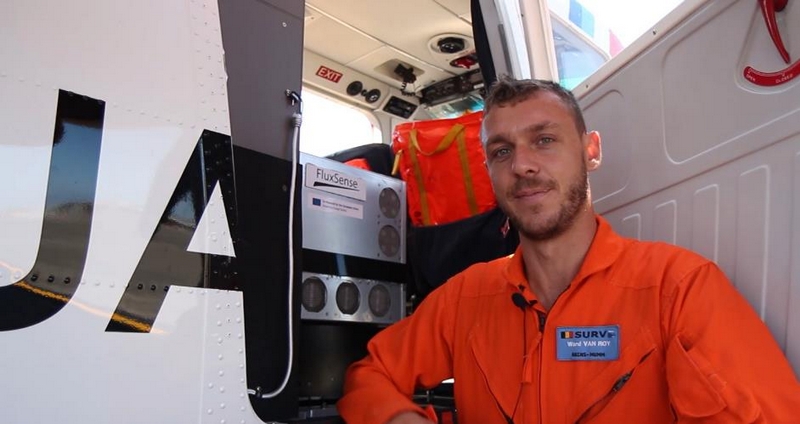
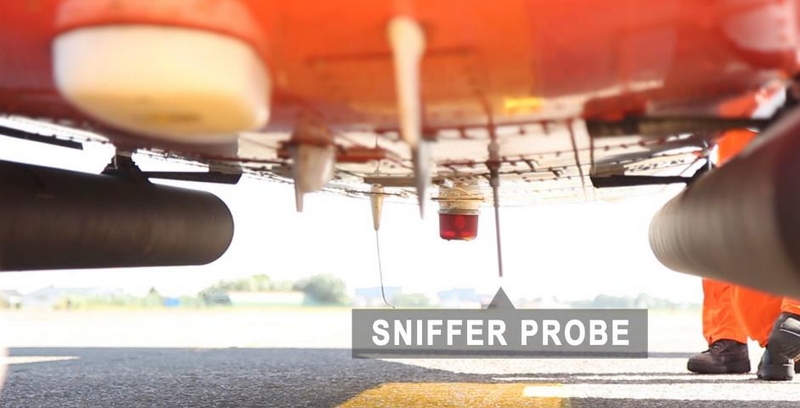
The sniffer system has tailor-made software for the operation of the sensor and the visualization of the measurements. The IGPS software, which stands for Identification of Gross Polluting Ships, makes use of an electronic sea map with integrated AIS (Automatic Identification System for ships) visualization. The ships are shown on the nautical map with an indication of the calculated location of the exhaust plume. These are calculated based on the actual wind data and the direction and speed of a ship, provided by the onboard computer. The sulphur content in the fuel of a ship is immediately calculated based on the SO2 and CO2 concentration measured in the smoke plume of the ship.
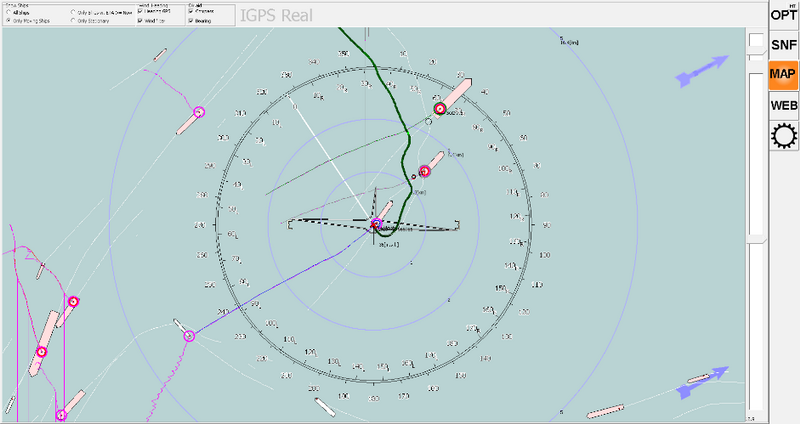
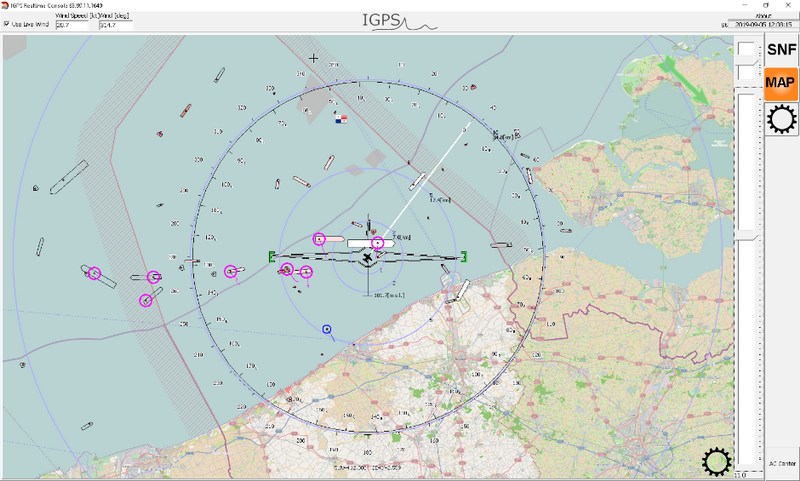
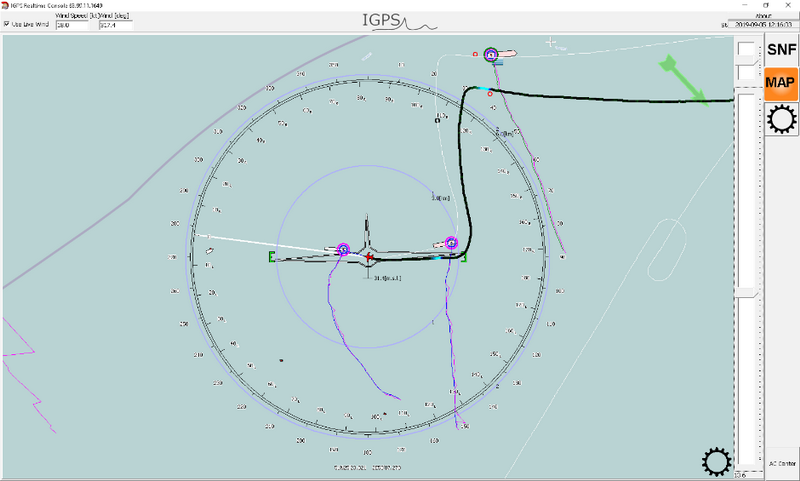
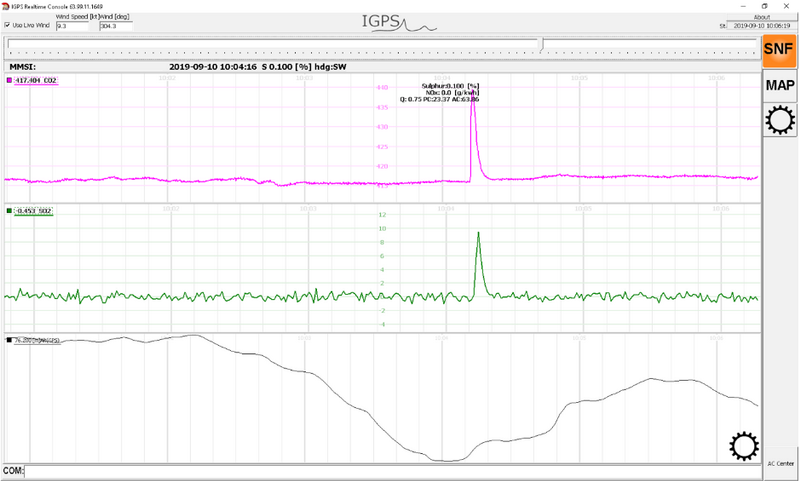
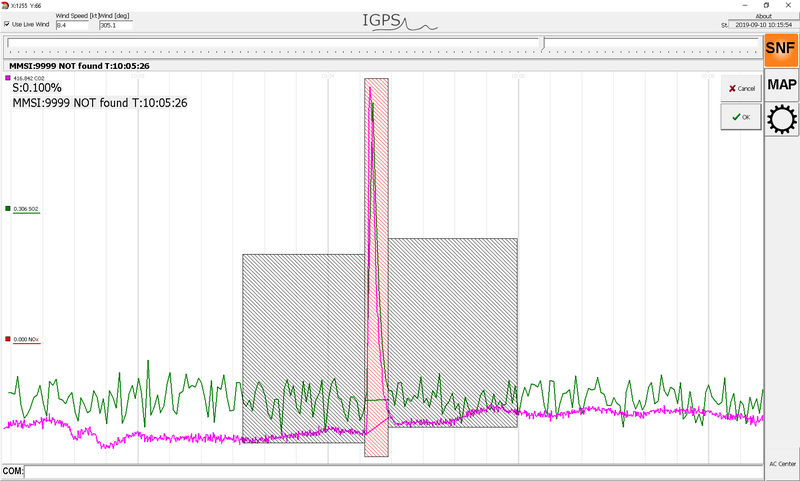
Flight procedures and ship approach
The sampling of smoke plumes from ships with a sniffer sensor is not without risk and a well-considered flight approach is crucial. Thus were there five different approaches determined based on the wind direction and strength, and the direction and speed of the vessel (see "CompMon" Best Practice Report).
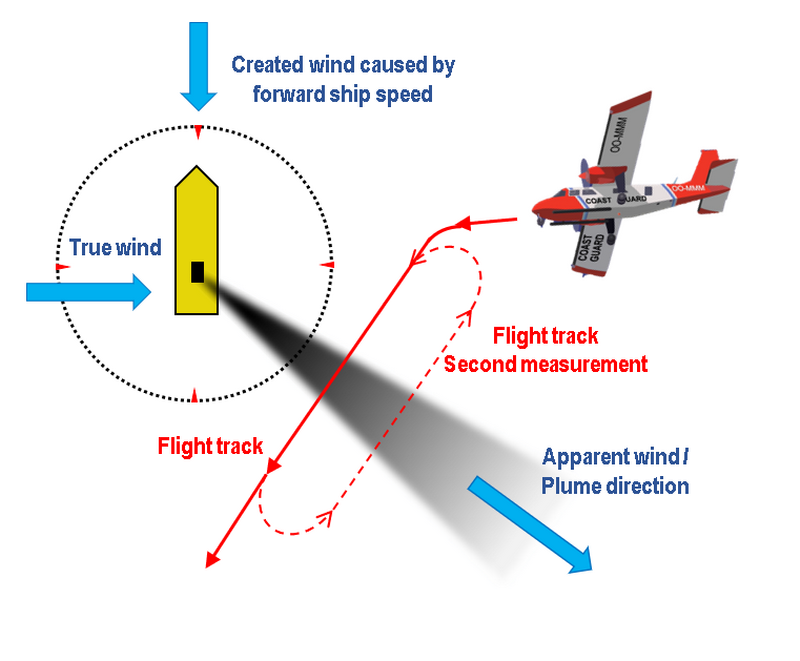
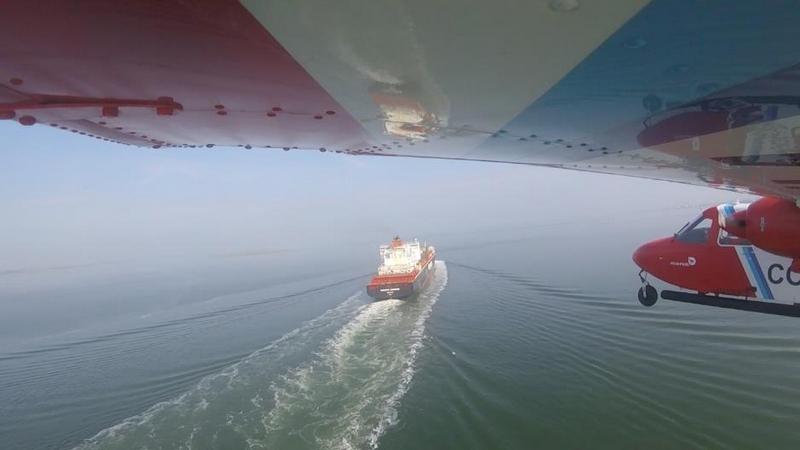
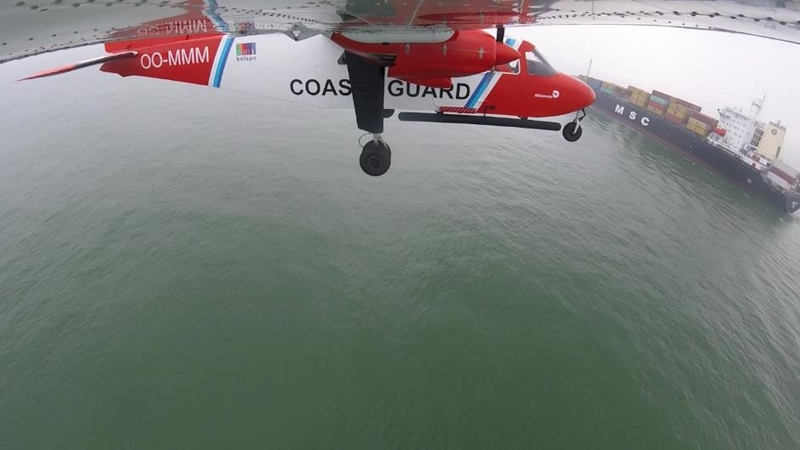
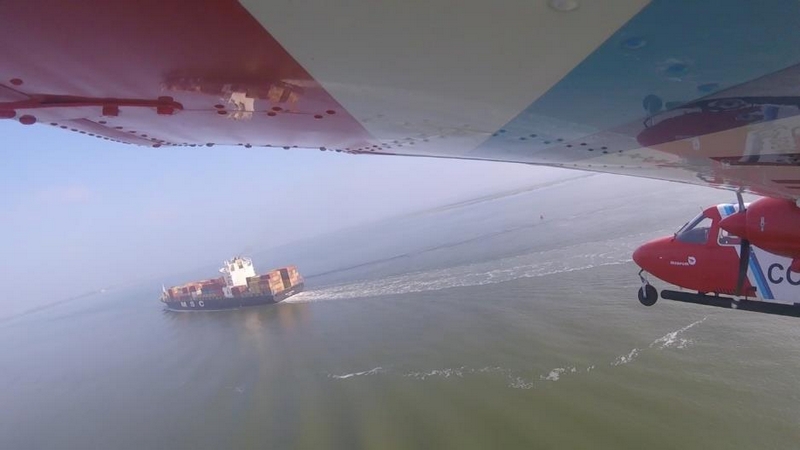
The most important principle of a ship approach is never to fly straight to a ship and that the plume of smoke is sampled at an angle of around 90 °. Depending on the wind speed and direction, the smoke plume can be higher or lower than the height of the outlet of the vessel. The localization of a ship's emission plume can sometimes be a challenge, but with trained pilots, one measurement attempt is often enough to achieve a successful measurement.
If a first measurement of the emission of a sailing ship shows that the ship uses the correct fuel, the Coast Guard aircraft will continue its route. If, however, at a first pass through an exhaust plume of a ship no successful measurement or a suspicious result is obtained, the aircraft will perform an additional passage with a maximum of 2 additional passages. If the alleged violation is confirmed by a second measurement, the suspect sulphur values are noted and after landing forwarded to the appropriate port inspection for further follow-up .
Targeting of suspicious ships and enforcement
A crucial point in the use of aerial monitoring for the enforcement of MARPOL Annex VI is cooperation and communication with the European port inspection network or Port State Control (PSC). PSC is responsible for conducting and coordinating inspections of vessels in ports (to implement the EC directive and 2016/802 and 2015/253 ). Before there were sniffer measurements at sea, the selection of ships for inspections and sampling was almost ‘ad random’. In addition, only a limited number of ships calling a port can be inspected.
Due to the targeting of suspicious vessels based on air monitoring port inspections and sampling can be conducted in a more targeted way so they become more efficient. Moreover, ships that leave EU ports and depart out of the SECA region or that are in transit were not controlled through PSC inspections, meaning compliance rates based on PSC inspections gave a distorted picture of the real situation. The findings of sniffer measurements at sea are therefore systematically reported to the competent inspection services, which then mark the suspect ships in a European database (Thetis-EU database). These ships are then priority eligible for a thorough check on board in their next European port of call. In Belgium such inspections are carried out by DG Shipping (FPS Mobility).
With these regular sniffing flights to improve the enforcement of sulphur emissions from ships, Belgium currently plays an international pioneering role. Purely based on sniffer measurements at sea no official statements are drawn up (yet), this only happens if sufficient evidence of an infringement is found during a port inspection and fuel sampling. Sulphur measurements today at sea with the sniffer sensor therefore mainly serve as a targeting system to make port inspections more effective.
Results
In 2019, the Coast Guard aircraft of MUMM has monitored the sulphur emissions of ships in Belgian and neighboring waters for the fifth year in a row. The results summarized below represent the figures for the first 5 years (2015-2019). In this period the aircraft operated for a total of 270 sniffer flights, which together accounted for 418 flight hours. During these sniffer flights a total of 4600 smoke plumes from ships were checked, of which 3059 were of individual ships. This amounts to an average of more than 10 ships per flight hour.
There were 367 potential identified violations, which were systematically submitted to the competent port inspection for a board examination. Approx. 90% of the ships off our coast showed to follow the strict sulphur emission limits despite the associated high costs which is good news for air quality. At the same time, however, this means that just under 10% of ships checked at sea were probably in violation. An efficient enforcement and approach of these 10% potential offenders is therefore absolutely necessary to guarantee maximum compliance with the strict emission limits from shipping and to create a level playing field in the shipping sector.
Based on the enforcement experience gained so far, a 'colour flag' system was developed and used to report alleged MARPOL Annex VI violations to the port inspection services. The reporting via this 'colour flags' shows the various degrees of probability of violation, taking into account, the calculated FSC-value for a particular vessel, the level of precision, and the uncertainty of the specific measurement:
-
Green flag: FSC measurements below 0.15% (considered as compliant)
-
Yellow flag: FSC measurements between 0.15 and 0.2% (considered as possibly non-compliant, with a confidence interval of 68%)
-
Orange flag: non-compliant FSC measurements between 0.2% and 0.4% (considered as non-compliant with a confidence interval of 95%)
-
Red flag: non-compliant FSC measurements of more than 0.4% (considered as non-compliant with a confidence interval of more than 99%)
A non-compliant result must in each case be confirmed by a second non-compliant measurement.
Analysis of the number of violations recorded by the port inspection shows that the measurements and reports generated by the airborne surveillance program have led to an increase in the efficiency of the port inspections by 50%.
Since the start of the sniffer measurements MUMM puts a lot of effort into informing other North Sea countries and the European Commission about the usefulness of the control flights over the sea, in the hope that this program in the near future will be extended around the North Sea (and to other European sea areas) in a joint approach to air pollution from ships.
International interest and cooperation
The clear pioneering role played by the Belgian government in this, along with few other European countries and institutions, has not gone unnoticed. In the meantime, active cooperation has been established with the Netherlands: In 2017 and 2018, MUMM carried out 25 hours of sulphur emission monitoring above Dutch waters on behalf of the Dutch government service ILT; this was expanded in 2019 to 35 flight hours.
Moreover, all North Sea countries are currently considering working in a joint way towards the deployment of sulphur emission monitoring operations over the wider North Sea (incl. The Channel), coordinated within the Bonn Agreement.
The sniffer operations and the gained experience and results in the area of subsequent harbour investigation and prosecution of offenders also led to interest within and outside Europe (other European marine regions, China, Canada, ...).
Towards monitoring at sea of NOx emission
Meanwhile, MUMM wants to improve the accuracy of the sulphur measurements, furthermore MUMM wants to expand its mission with the monitoring of nitrogen (the so-called NOx) emission from ships at sea, for which stricter standards will apply from 2021 on all over the North Sea, by the entry into force of the so-called NECA (NOx Emission Control Area).
For this monitoring expansion, a modified NOx sensor is purchased, for integration into the sniffer sensor system onboard the air surveillance aircraft. The NOx sensor is capable of measuring NOx concentrations (in ppb) in the exhaust plumes of ships. For this purchase, in 2019, the cabinet of the Secretary of State for the North Sea, Philippe De Backer, made a total budget of € 70,000 available to the FPS Science Policy (MUMM). Thanks to this expansion of the sniffer sensor system, MUMM will be able to:
-
increase the accuracy of the sulphur measurements, given the slight cross-sensitivity to NOx by the SO2 sensor, which can be eliminated with NOx measurements
-
carry out NOx enforcement at the sea, which is very valuable because there is no empirical control method for NOx to perform enforcement in the port (monitoring is only possible based on certification and not on the basis of measurements or sampling)
Through the NOx sensor, an enormous amount of information will be collected about the NOx emission from ships at sea. This should lead to a better understanding of how effective offshore NECA monitoring can be worked out to improve NECA enforcement in collaboration with the port inspection services (PSC). This way MUMM continues its pioneering role in the field of ship emission monitoring at sea.


